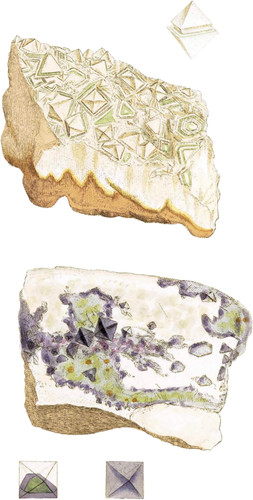 Enlarge
Enlarge
British Mineralogy
Primitive crystallized Fluate of Lime; or Fluor
- Class 2. Earth.
- Ord. 1. Homogeneous.
- Gen. 1. Lime.
- Spec. 3. Fluate of Lime.
- Div. 1. Crystallized.
- Syn.
- Chaux fluatée primitive. De Lisle, t. 2. p. 15.
- Haüy, v. 2. 249. t. 31. f. 74.
- Rashleigh, v. 1. t. 24. f. 1.
Octaedral fluor is rare, as I have observed at t. xi of this work. The upper figure of the present plate is from a specimen given me by the Right Honourable Charles Greville. It is found at Beer Alston, in Devonshire. I have never seen any of an opaque white but from thence; and, which is an addition to the curiosity of the specimen, the crystals here are alternately opaque white and transparent green, being as it were cased upon one another, 5, 6, or more times. The transparent kind gives the usual vivid glow when laid upon a hot poker, soon crackling and flying away. The white part does neither, and will remain as a defence to the next transparent part, until a stronger heat bursts it. The matrix is commonly hornstone in apparently broad strata, next to a sandy one on the side opposite to the fluor; with considerable hollows, seemingly the impressions of some large confused crystallization that had been in the next strata. This hornstone, from specimens given me by Lord Healthfield, has sometimes apparently very large green octaëdral fluor on it, covered with quartz crystals, and some varieties of octaëdral pyrites. The irregular fracture of the former gives the matrix an odd appearance, somewhat resembling the ground plan of a fortification, and not unlike what is called fortification agate, found on the Scottish coast. The figure at the top of the plate shows the octaëdron and its cases.
The lower figure is octaëdral fluor, from Aberdeenshire. I believe this may be the first time it has been noticed*. They are of a dark purple, but do not detach so freely as the above: they are lighter purple or greenish on the inside and are heaped confusedly in a stratum of calcareous spar and cawk, if I am not deceived. The figures at the bottom are octaëdrons lying on one of the faces, to show that the fracture which is parallel to the face gives a hexangular form, as expressed at the left-hand figure, and will account for the hexaëdral remains of the crystal in the figure. The more triangular fractures are nearer the primitive faces.
- * Jameson does not observe any thing more than that fluor has been found in Aberdeenshire. I think if he had seen any octaëdrons he would have said so.

